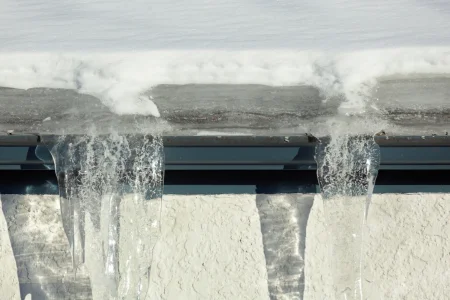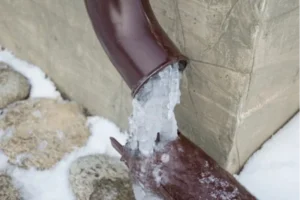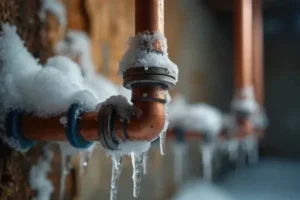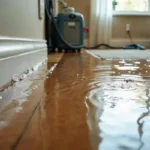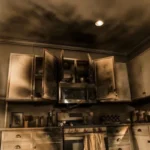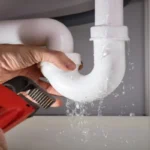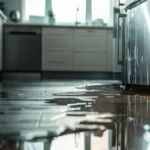Winter brings snow-covered roofs, cozy nights, and festive charm—but it also comes with hidden risks for your home. From frozen pipes to ice dam roof leaks, cold weather can quickly turn into a costly repair nightmare. Let’s explore the most common causes of winter water damage and learn how to prevent them to help protect your property throughout the season.
Understanding the causes of winter home damage can help you protect your property before it’s too late. Common water damage in the winter often results from frozen pipes, roof leaks, or poor insulation.
Let’s take a closer look now!
Understanding Winter Water Damage
When temperatures drop, water can become one of your home’s biggest threats.
What is Winter Water Damage?
In simple terms, this damage refers to any water-related issue caused by freezing weather. It often results from frozen pipes, ice dams, or winter storm damage, which can lead to leaks and flooding. Left unchecked, these problems can weaken structural elements, promote mold growth, and create expensive long-term repairs.
Why Homes Are More Vulnerable During Cold Months
Poor insulation, gaps around windows, or unheated basements increase the risk of frozen and burst pipes in winter. On the roof, melting snow refreezes along the edges, forming ice dams that force water under shingles. These vulnerabilities make winter damage more likely—but with the right prevention, most can be avoided.
Common Causes of Winter Water Damage
Many factors can contribute to water damage, but a few culprits stand out as the most frequent offenders:
Frozen and Burst Pipes
When water inside a pipe freezes, it expands and can cause the pipe to burst, releasing gallons of water once it thaws. To prevent ice buildup, insulate exposed lines in basements, attics, and crawl spaces. Additionally, keep your thermostat set above 55°F and let faucets drip slightly during extreme cold.
Ice Dams on Roofs
An ice dam roof leak happens when melting snow refreezes along your roof’s edge, blocking proper drainage. Water trapped behind the ice can seep under shingles, causing leaks, rot, and interior damage. To prevent this, keep your roof well insulated and ventilated, and safely remove snow after heavy storms. Installing heat cables along the eaves can also help keep water flowing.
Leaky or Clogged Gutters
Overflowing gutters lead to roof leaks and foundation issues. For effective water damage prevention, clear leaves and debris regularly, check for cracks or sagging, and consider installing gutter guards. Maintaining proper drainage now can save thousands in future repairs.
Poor Insulation and Ventilation
When your home isn’t properly insulated or ventilated, cold air sneaks in while moisture gets trapped inside. That combination can cause condensation, mold, and even burst pipes in winter. Check the attic and basement insulation, seal gaps around doors and windows, and ensure vents are unobstructed.
Foundation or Basement Cracks
Even small cracks in your foundation can become entry points for melting snow and groundwater. As temperatures fluctuate, those cracks expand, allowing more moisture in. Regularly inspect your basement and exterior walls, seal any gaps with waterproof caulk, and make sure your yard slopes away from your home.
H2: Signs You Might Have Winter Water Damage
Spotting water damage early can prevent major repairs later. Keep an eye out for these telltale warning signs around your home:
Stains or Damp Spots on Walls and Ceilings
Discoloration, peeling paint, or flaking plaster may indicate hidden leaks resulting from water damage. These stains often appear after heavy snow or periods of thawing, indicating that moisture is seeping through walls or ceilings. If you notice them, act fast—moisture spreads quickly once it gets inside.
Musty Odors or Mold Growth
A damp, musty smell or visible mold is a red flag that water is trapped somewhere in your home. This often happens after burst pipes in winter or slow leaks behind walls. Mold can spread fast and affect air quality, so locate and repair the source immediately, then dry the area thoroughly.
Unexplained Spikes in Water Bills
If your water bill suddenly jumps during cold months, it may signal a hidden leak caused by freezing or cracking pipes. Inspect areas where pipes are exposed—like under sinks, in basements, or behind appliances. Catching leaks early can prevent extensive damage and costly repairs.
How to Prevent Winter Water Damage
The best way to handle water damage is to prevent it altogether. A few proactive measures can make all the difference.
Insulate Pipes and Keep Indoor Temperatures Stable
Insulate exposed pipes with foam sleeves or heating tape. Keep cabinet doors open under sinks to let warm air circulate and avoid shutting off the heat entirely when away from home. Consistent warmth keeps your plumbing safe from freezing.
Clear Gutters and Inspect Your Roof Regularly
Clean gutters before winter begins and after major storms to prevent blockages that lead to ice dam roof leaks. Inspect your roof for damaged shingles or flashing, and repair any problem areas immediately. Preventive maintenance is far cheaper than a full restoration.
Seal Foundation Cracks and Improve Drainage
Check your basement and foundation for cracks and seal them with weatherproof material. Ensure the ground slopes away from your home to divert melting snow. Installing French drains or extending downspouts can further protect your foundation.
Use a Dehumidifier to Control Indoor Moisture
Cold air outside doesn’t mean humidity isn’t an issue indoors. A dehumidifier helps maintain optimal moisture levels, preventing condensation, mold growth, and water damage. It’s especially helpful in basements, laundry rooms, and bathrooms.
What to Do If You Discover Water Damage
If damage does occur, quick action is key to minimizing long-term issues.
Turn Off the Water Supply Immediately
Locate your main water shut-off valve and turn it off to stop further flooding. Avoid using appliances or faucets until the issue is inspected. This step helps limit additional damage and can save you money on repair costs.
Document the Damage for Insurance Claims
Take clear photos and videos of affected areas, note dates, and keep receipts for repairs or temporary housing. This documentation helps streamline your insurance claim and ensures you’re fairly compensated for the damage.
Contact Professional Restoration Experts
Professional help is essential for safe and thorough recovery. Trained technicians can assess the extent of the damage, extract standing water, prevent mold, and restore affected materials. Don’t delay—a fast response makes all the difference.
Why Choose SS Water for Water Damage Restoration
When disaster strikes, SS Water Restoration is your trusted partner. Find out why:
24/7 Emergency Water Damage Services and Fast Drying Solutions
Water damage doesn’t wait—and neither do we. Our team responds around the clock with specialized drying equipment and customized recovery plans to restore your home efficiently.
Insurance Claim Support and Transparent Estimates
Navigating insurance paperwork can be stressful, but our team walks you through every step. We provide honest and upfront estimates, helping you understand your policy coverage so that there are no surprises.
Experienced Technicians Trained in Cold-Weather Restoration
Our restoration specialists are trained specifically to handle the challenges of winter. From frozen pipes to ice dam leaks, we use proven techniques and the latest tools to restore your home quickly and safely.
Conclusion—Keep Your Home Protected This Winter
Learning how to detect winter damage—such as spotting stains, damp walls, or mold—can prevent costly repairs. Knowing how winter water intrusion happens through cracks, ice dams, or foundation shifts empowers homeowners to take proactive steps and safeguard their home year-round.
Whether you’re dealing with a frozen pipe or storm-related flooding, having reliable help makes recovery easier. Don’t let winter water damage disrupt your home—contact SS Water Restoration today for expert inspection and repair!
By staying proactive and addressing vulnerabilities before freezing temperatures hit, you can significantly reduce your risk of water damage. Keep your pipes insulated, clear your gutters, and inspect your foundation regularly to prevent potential issues. If you spot trouble, act fast—and know that SS Water is here to help restore and protect your home when you need it most.
Frequently Asked Questions
1. How can I tell if my roof is at risk for winter damage?
2. What insurance coverage should I have for winter water damage?
3. Can winter water damage affect my home’s foundation?
4. Are there specific materials resistant to winter water damage?
5. How often should I check for winter water damage?
6. What should I do before winter to prevent water damage?

